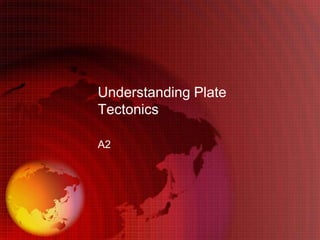
Lecture 3 understanding plate tectonics
- 2. The History • Alfred Wegener 1915 • First came up with the theory that the earth’s plates were slowly moving in relation to each other (Continental Drift) • It was not until the 1960’s and Harry Hess who proposed that it was caused by sea floor spreading at mid ocean ridges • This was where the modern history of plate tectonics begins
- 3. Why do we have tectonic Plates • The earth has 7 large plates • 7 smaller ones • And dozens of micro plates • The earth’s surface is broken up into plates because the heat generated in the earth's core by radioactive decay drives convection currents in the outer core and mantle. • These slowly tear the earth apart and are responsible for movement • This movement will continue as long as heat is generated at the core
- 4. All Major and Minor Plates
- 5. How do the move? • Plates come in two types Oceanic and continental • Oceanic Plates – Are young, thin and dense. – They are formed on the sea floor spreading at constructive plate boundary ridges and destroyed at Subduction zones – Most are under 150 million years old and made of dense Basalt (6-8km thick)
- 7. Continental Plates • Are ancient thick and less dense • They are over 4 billion yrs old and are not being formed today • They are made of less dense Granite and are 30-60km thick
- 8. Convection • At the rising limbs of convection cells, heat from the core moves towards the earth’s surface then spreads to either side. • It is this spreading motion that splits the plates and drags them apart. • Plates move on a layer between the upper mantle and lithosphere. The asthenosphere acts as a type of lubrication • The plate motion depends however on two factors: – The weight of the cold plates at the subduction zones pulling the plate downwards – Gravitational sliding force between ‘High’ and ‘Low’ Trenches
- 9. Convection Currents Layer Physical State Lithosphere Solid, rigid Earth’s Crust) Asthenosphere Solid, plastic, (partially molten approx 4%) Mantle Solid, plastic Outer core Liquid Inner Core Solid (Iron and Nickel)
- 11. Hazards • Most occur where the plates meet. Boundary Hazards • There are rare ‘Intra-plate earthquakes’ and ‘Mid-plate volcanic hotspots’ • There many different tectonic ‘settings’ which produce various hazards
- 12. Settings SETTING MOTION HAZARDS EXAMPLE CONSTRUCTIVE 2 Oceanic plates moving Basaltic volcanoes and Mid-Atlantic ridge PLATE BOUNDARY apart minor , shallow (Iceland) mostly earthquakes submerged) 2 continental plates Basaltic splatter cone African Rift Valley and moving apart volcanoes Mnt. Niyragongo DESTRUCTIVE PLATE 2 oceanic plates in Island arc explosive Soufrierre Hills on BOUNDARY collision Andesite eruptions and Montserrat EQ’s 2 continental plates in Major, shallow Himalayan orogenic belt collision earthquakes along thrust faults Oceanic and continental Explosive, andesitic Andes mountain chain plate collision eruptions and major EQ TRANSFORM Plates sliding past one Major shallow San Andreas fault BOUNDARY another earthquakes HOTSPOTS Oceanic Basaltic shield Hawaiian Island chain volcanoes, minor earthquakes Continental Colossal Rhyolitic mega- Yellowstone eruptions ‘supervolcano’ USA
- 13. Research Task • What caused and started the following earthquakes: • San Francisco 1906 • Great Kanto (Tokyo) 1923 • Chile 1960 • Mexico City 1985 • Izmit Turkey 1999 • Kashmir 2005
- 14. Volcanoes • Why aren’t they all the same? • We have discussed the reasons for why not all volcanoes are the same – Basaltic – basic magma – Andesitic – Intermediate – Rhyolitic – Acidic magma
- 15. Basaltic • Very hot iron rich silica poor • Low gas content and very hot runny lava (Melted ice cream) • Can erupt almost continuously • Not very explosive
- 16. Andesitic • In the middle between rhyolitic and basaltic • Sticky can take decades or centuries between eruptions • Can be very explosive
- 17. Rhyolitic • High silica content low temperature and high gas content therefore combustible • Erupt rarely • Can be devastating
- 18. The Richter Scale • Developed in 1935 to measure magnitude of earthquakes • Today the Moment Magnitude Scale MMS id more commonly used and is very similar • Most earthquakes over 6.5 on the Richter scale generate interest as at this magnitude they will cause some, if not significant damage • However this does not tell the whole story
- 19. Earthquake Depth • Shallow surfaced EQ’s (<70km) intermediate (70-300km) Deep focused (>300km) • Shallow ones are the most destructive as less energy is lost travelling to the surface • Especially important in the Benioff Zone of subducting plates
- 20. The Benioff Zone • This is the active seismic zone on a subduction plate • In a subduction zone the earthquake foci normally plots along a dipping plane at an angle of 33 to 60 degrees and this plane is called a Benioff zone • It is named after Hugo Benioff, a US seismologist who first described this feature • The Benioff zone extends to a depth of about 700 km
- 21. Physical Nature of the Ground • If the ground consists of loose sediment then liquefaction can occur • In high mountain areas such as the Himalayan fold mountains landslides can have devastating effect.
- 22. Finally • After looking at these your research should take into account the ‘Settings’ of the events as this will help you understand the impacts that it has on humans
- 23. References • Leeds University Lecture Notes
